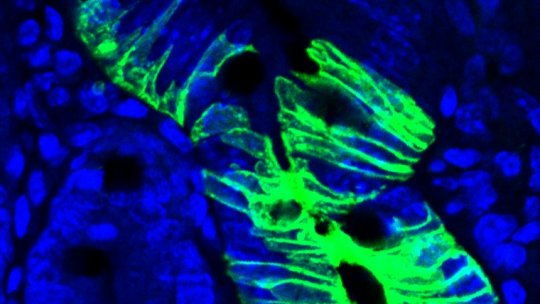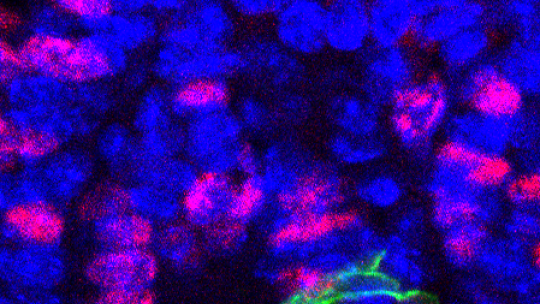Images
Participants
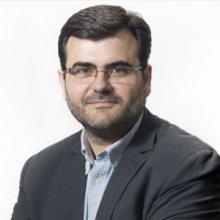

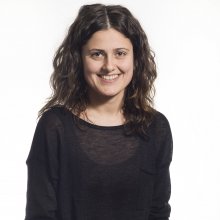


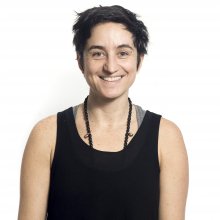
Contact

These comprise a small group of passive stem cells—quiescent—that are activated when needed and have the capacity to produce any kind of intestinal cell.
Quiescent cells are relevant for tissue regeneration and for their participation in tumour development.
The intestine has a high rate of cellular regeneration due to the wear and tear originated by its function degrading and absorbing nutrients and eliminating waste. The entire cell wall is renewed once a week approximately. This explains why the intestine holds a large number of stem cells in constant division, thereby producing new cell populations of the various types present in this organ.
Researchers at the Institute for Research in Biomedicine (IRB Barcelona) headed by ICREA investigator Eduard Batlle, head of the Colorectal Cancer Laboratory, have discovered a new group of intestinal stem cells with very different characteristics to those of the abundant and active stem cells already known in this organ. Performed in collaboration with the Centre Nacional d'Anàlisi Genòmica (CNAG-CRG), the study has been published in Cell Stem Cell. These new group of stem cells are quiescent, that is to say, they do not proliferate and are apparently dormant.
The researchers describe them as a reservoir of stem cells—it is estimated that there is one quiescent cell for every 10 active intestinal stem cells. In healthy conditions, these cells have no apparent relevant function. However, they are important in situations of stress, , for example, after chemotherapy, in inflammatory processes, and in tissue infections—all conditions in which the population of “normal/active” stem cells is depleted. These quiescent cells would serve to regenerate the organ by giving rise to the various types of cells present in the intestine, renewing the population of “normal/active” stem cells, and restoring balance to the tissue.
Eduard Batlle explains that the discovery of quiescent stem cells in the intestine reveals that stem cell biology is more complex that previously appreciated and that it does not follow ahierarchical model of cell organisation. "In intestinal cell hierarchy, there are no cells above others, so the two populations are in a continual balance to ensure the proper function of the organ".
Most drugs against cancer have a secondary effect on the cells that are dividing in our tissues. “Because quiescent stem cells divide infrequently, they are resistant to many types of chemotherapy and they regenerate the tissue that this treatment has damaged," explains Eduard Batlle, head of one of the labs of international prestige in research into intestinal stem cells and their involvement in colorectal cancer.
Quiescent cells are present in many kinds of tissue. However, in spite of their relevance in tissue regeneration, increasing evidence points to their involvement in tumour development. "It is difficult to study these cells, mainly because they are scarce and there are technical limitations with respect to monitoring, straining and distinguishing them from the others," explains Francisco Barriga, first author of the study and current postdoctoral fellow at the Memorial Sloan Kettering Cancer Center in New York.
Using advanced techniques, such as genetic tracing of cell lineages and transcriptomic analysis of individual cells, performed by CNAG-CRG and the Bioinformatics and Biostatistics Unit at IRB Barcelona, the group has identified the distinct genetic programme used by quiescent stem cells with respect to normal intestinal ones. This work has been done over six years.
The researchers have labelled this cell population with a specific marker, the Mex3a protein, which has allowed them to track it over time. "We intend to continue studying quiescent stem cells in health and disease and to discover the function of the genes that distinguish them in the colon and in other organs," says Batlle.
This work has received funding from the European Research Council (ERC Advanced Grant), the Fundación Botín/Banco Santander Universidades and the Spanish Ministry of Economy and Competitiveness/ERDF Funds.
Reference article:
Francisco M. Barriga, Elisa Montagni, Miyeko Mana, Maria Mendez-Lago, Xavier Hernando-Momblona , Marta Sevillano, Amy Guillaumet-Adkins,Gustavo Rodriguez-Esteban, Simon J. A. Buczacki, Marta Gut, Holger Heyn, Douglas J. Winton, Omer H. Yilmaz, Camille Stephan-Otto Attolini, Ivo Gut, and Eduard Batlle
Mex3a marks a slowly dividing subpopulation of Lgr5+ intestinal stem cells
Cell Stem Cell (2017). doi: 10.1016/j.stem.2017.02.007
About IRB Barcelona
Created in 2005 by the Generalitat de Catalunya (Government of Catalonia) and University of Barcelona, IRB Barcelona is a Severo Ochoa Centre of Excellence, a seal that was awarded in 2011. The institute is devoted to conducting research of excellence in biomedicine and to transferring results to clinical practice, thus improving people’s quality of life, while simultaneously promoting the training of outstanding researchers, technology transfer, and public communication of science. Its 23 laboratories and seven core facilities address basic questions in biology and are orientated to diseases such as cancer, metastasis, Alzheimer’s, diabetes, and rare conditions. IRB Barcelona is an international centre that hosts more than 400 employees and 36 nationalities. It is located in the Barcelona Science Park. IRB Barcelona forms part of the Barcelona Institute of Science and Technology (BIST) and the “Xarxa de Centres de Recerca de Catalunya” (CERCA).
About IRB Barcelona
The Institute for Research in Biomedicine (IRB Barcelona) pursues a society free of disease. To this end, it conducts multidisciplinary research of excellence to cure cancer and other diseases linked to ageing. It establishes technology transfer agreements with the pharmaceutical industry and major hospitals to bring research results closer to society, and organises a range of science outreach activities to engage the public in an open dialogue. IRB Barcelona is an international centre that hosts 400 researchers and more than 30 nationalities. Recognised as a Severo Ochoa Centre of Excellence since 2011, IRB Barcelona is a CERCA centre and member of the Barcelona Institute of Science and Technology (BIST).

